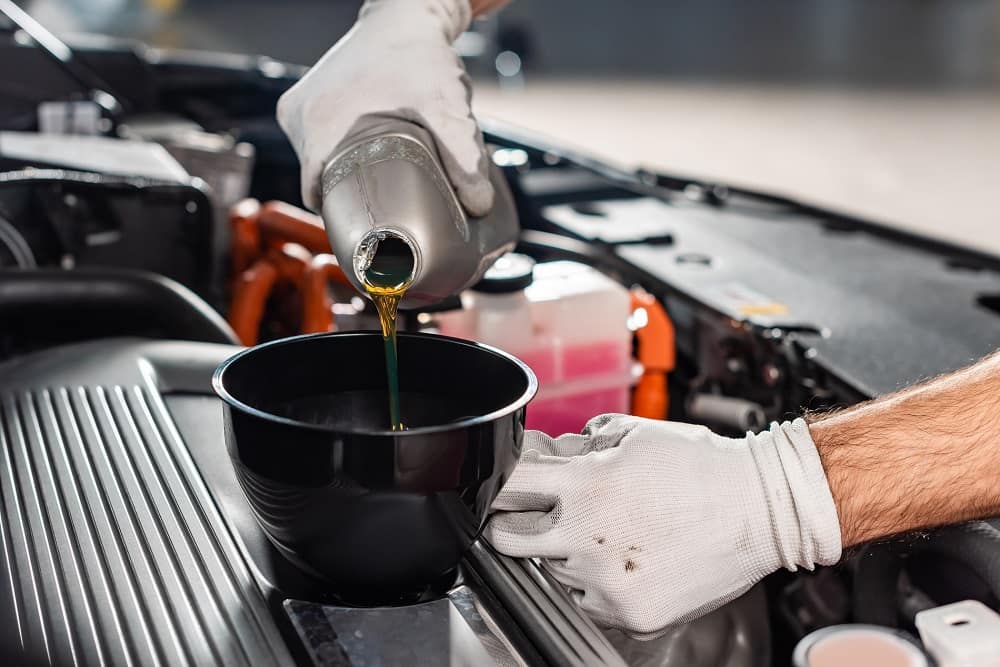
Oil Change Near Me
Drivers all across the East Stroudsburg, Stroudsburg, Bethlehem, Easton and Jim Thorpe area know that one of the most common forms of automotive service is the oil change. When you know that it's time for your vehicle to get an oil change, do you know where to go? Or do you find yourself asking, where can I get an oil change near me?
An oil change is an easy service to perform on your own, but for the best results, you'll want to consult the professionals. So to help you figure out when you're going to need an oil change near me, our team at Ray Price Honda is going to give you a few pointers. We'll let you know why oil is crucial to your vehicle and a few signs that indicate that you'll need your oil changed.
Related Post:
Why Do You Need An Oil Change?
Oil is crucial to your vehicle's performance and well-being. Your engine features many moving parts that are constantly rubbing against each other while the vehicle is in motion. Oil simply lubricates these parts so they can move fluidly without wearing away or creating friction. The oil helps cool these parts and disperses the heat the parts give off while performing.
While oil is necessary for your vehicle and its performance, it requires to be changed every couple thousand miles or so. Over time, oil becomes sludgy and less effective at both lubricating the parts and keeping them cool. When this occurs, you should find somewhere to get an oil change near you.

Signs You Need An Oil Change
Putting off the oil change, or simply ignoring the warning signs could lead to significant damage that would cost thousands in repairs. That's why it's important to be keep an eye out for these various warning signs. Here are a few of the signs that you should look for that are telling you it's time to schedule an oil change.
The Check Engine Light Has Appeared
In the same way your fuel light may come on when your car needs more gas, the oil warning light alerts you of low oil levels. Gauges and sensors monitor the oil pressure levels and notify when they drop beyond a safe level. If you notice the light flickering on your dashboard, pop the hood to check your oil levels.
Simply remove the dipstick and wipe it on a cloth or towel (preferably a white cloth to check for the oil's color). If you noticed a dark color as opposed to a more golden shade, you may want to schedule an oil change since dirt has entered the oil. Insert the dipstick fully and remove it again to check the current level. If the levels are low, add fresh oil until you reach the fill line.
The Oil is Dark in Color
When you go to check the oil level using the dipstick, take a rag and wipe the dipstick so you can see the oil and its color. When oil is fresh, it almost has a honey color. But when oil is nearing the end of its lifespan, it will have a black and sludgy-looking appearance.
Oil has a variety of functions with your vehicle, one of which is keeping your engine components clean. In doing so, it actually picks up the dirt and debris, which leads to its discoloration. When you notice that your oil is dark in color, you may want to schedule an oil change in the near future.
Unusual Engine Noises
One of your oil's main functions is to keep the moving metal parts and components in your engine well lubricated. It allows these parts to move efficiently without causing too much strain on each other. However, when your oil becomes dirty, gritty, and less effective, these parts will start to make louder noises that are easily noticeable. Listen for any clicking, knocking, or grinding sounds during your trips, because they could be telling you that it's time for an oil change.
Burning Oil Smell
From time to time, leaks occur under the hood which require immediate attention. If you notice a foul burning oil odor, you may have an oil leak and the surrounding hot engine parts could be in jeopardy.
If you notice the smell while driving, pull over immediately to allow the engine to cool. Once cooled, check your oil levels with the dipstick to determine if a leak is possible and whether you can continue driving or not. If the levels are low, do not continue; contact your local service provider for a tow.
Clunking and Knocking
The two main reasons oil is essential for your vehicle is its ability to both lubricate all the various gears and parts while distributing heat to keep the engine in healthy shape. As dirt collects in the oil or as fluid levels decrease, the effectiveness of the engine and its parts suffer.
The constantly moving inner-workings of the engine and its components can cause loud knocking, grinding, or clunking sounds. When you hear the noticeable banging of either a broken rod or other unhinged part, seek immediate service to prevent further damage.
How Long Does an Oil Change Take?
You know just how important routine maintenance is for keeping your car in great condition. But, you also have a busy schedule, and you need to find time for auto repair that fits your agenda. So, just how long does an oil change take?
Oil changes are very quick and generally take between 15 and 45 minutes to complete. A range of factors will affect your waiting time, and we at Ray Price Honda will give you a full breakdown below. If you need an oil change near Stroudsburg, Easton, or Jim Thorpe, read this article and call us for more information!

How To Change Your Oil?
Whether you're enlisting a trained technician or handling the oil change yourself, the process is roughly the same-although technicians may have access to more advanced equipment to make some steps (like lifting the car) quicker and easier. Here are the steps on how to change your oil:
- Lift the car to access the oil drain plug.
- Place a pan under the oil drain plug and unscrew.
- Wait while the oil drains out into the pan and then replace the plug.
- Remove the cap from the oil filler hole and unscrew the oil filter.
- Screw in a new filter and add new engine oil.
Waiting for the oil to drain is the most time-consuming step in the process; you may be waiting 15 minutes for it to fully drain. The good news is, you or your technician can move on to the next step (changing the filter) while the oil is draining, potentially saving a lot of time overall.
Reasons Why Regular Oil Changes Are So Important
It's no secret that engine oil is one of the most essential components of your car. Your engine is made up of many moving metal parts, and it needs oil as a lubricant to keep those parts running smoothly. Oil will help reduce friction and the risk of your engine overheating, which is crucial for a healthy engine.
All that is fine and well, but why does engine oil need to be changed? Like other fluids operating in a hot environment, oil is subject to breaking down or becoming contaminated over time. By regularly changing your oil and filter, you can avoid excessive wear and tear on your engine-and costly engine repairs.

How Often Should You Change Your Oil?
The rate at how often you should change your oil depends on the make and model of your car-and the type of engine oil you use. Your best bet is to check your vehicle owner's manual and see what your car's manufacturer recommends.
A good, general rule of thumb is to have oil changes performed every six months or 5,000 miles. If you use synthetic oil, you may be able to extend that interval-possibly up to 12 months or 10,000 miles, or even longer. Again, checking your owner's guide is the best policy here, as every car runs differently.
How Do You Know What Oil Your Car Needs?
Before you put motor oil into your vehicle, it's a good idea to learn about the different types that you could choose and how they might affect your vehicle. Here are a few tips for choosing the correct motor oil for your vehicle and advice for scheduling regular maintenance from a trusted repair service.
Oil Standards
One of the most important factors to consider when choosing motor oil is whether you're buying a brand of oil that has been tested and meets the standards of professional organizations. This means you should be certain that any oil you choose has been tested by the American Petroleum Institute, which should be indicated on the motor oil label.
Also, you should make sure that your oil has the SL service designation. This indicates that the motor oil has been subjected to engine and lab tests to ensure its quality. Any oil worth your time and expense should meet the standards laid out by the API.
Oil Viscosity
The second factor that you need to examine when buying motor oil is its viscosity, which is how resistant the oil is to flow. Motor oil will thin when it gets warmer and get thicker when it cools. If you don't choose an oil with the right viscosity, then your vehicle may be very vulnerable to temperature swings.
A motor oil's viscosity is represented by two numbers. On the label, you will see the letter W, which stands for winter. The number before the W is how resistant the oil is to thickening and the number after the W is how well it resist thinning. Ideally, the first number will be low and the second number will be high, meaning your oil will perform the way you need in a wide range of temperatures.
Choosing Oil
The final and most important step in adding oil to your car is picking the type of oil that is ideal to use, which will largely depend on the type of vehicle you have. For instance, most vehicles will use premium conventional oil because it is available in several viscosities.
If you have a high-tech engine, then you will probably want to use full synthetic oil, as they go through strict testing and perform better at extreme temperatures. Vehicles that operate in high temperatures and haul heavy loads may need synthetic blend oil. Finally, if you have a vehicle with a lot of miles on the odometer, you need higher mileage oil that is specifically designed for high-mileage vehicles.
Where to Get an Oil Change?
If you've detected any of these signs, or you've kept track and know that you need an oil change near me, you can always contact us at Ray Price Honda. Our team of technicians perform oil changes daily, so you can relax knowing that your vehicle is in the hands of experts. We'll change the oil, the oil filter, and we'll properly dispose of your old oil.
Is it time for an oil change near you? Contact us at Ray Price Honda, we're always happy to help drivers in the East Stroudsburg, Stroudsburg, Bethlehem, Easton and Jim Thorpe area.
Our Automotive Service Center is located at 6310 Route 209 Stroudsburg, PA 18360.
Make an Inquiry
* Indicates a required field

